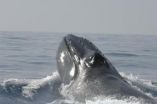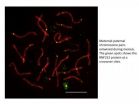(Press-News.org) CORVALLIS, Ore. – The greatest battle in Earth's history has been going on for hundreds of millions of years, isn't over yet, and until now no one knew it existed, scientists reported today in the journal Nature.
In one corner is SAR11, a bacterium that's the most abundant organism in the oceans, survives where most other cells would die and plays a major role in the planet's carbon cycle. It had been theorized that SAR11 was so small and widespread that it must be invulnerable to attack.
In the other corner, and so strange looking that scientists previously didn't even recognize what they were, are "Pelagiphages," viruses now known to infect SAR11 and routinely kill millions of these cells every second. And how this fight turns out is of more than casual interest, because SAR11 has a huge effect on the amount of carbon dioxide that enters the atmosphere, and the overall biology of the oceans.
"There's a war going on in our oceans, a huge war, and we never even saw it," said Stephen Giovannoni, a professor of microbiology at Oregon State University. "This is an important piece of the puzzle in how carbon is stored or released in the sea."
Researchers from OSU, the University of Arizona and other institutions today outlined the discovery of this ongoing conflict, and its implications for the biology and function of ocean processes. The findings disprove the theory that SAR11 cells are immune to viral predation, researchers said.
"In general, every living cell is vulnerable to viral infection," said Giovannoni, who first discovered SAR11 in 1990. "What has been so puzzling about SAR11 was its sheer abundance, there was simply so much of it that some scientists believed it must not get attacked by viruses."
What the new research shows, Giovannoni said, is that SAR11 is competitive, good at scavenging organic carbon, and effective at changing to avoid infection. Because of that, it thrives and persists in abundance even though it's constantly being killed by the new viruses that have been discovered.
The discovery of the Pelagiphage viral families was made by Yanlin Zhao, Michael Schwalbach and Ben Temperton, postdoctoral researchers working with Giovannoni. They used traditional research methods, growing cells and viruses from nature in a laboratory, instead of sequencing DNA from nature. The new viruses were so unique that computers could not recognize the virus DNA.
"The viruses themselves, of course, appear to be just as abundant as SAR11," Giovannoni said. "Our colleagues at the University of Arizona demonstrated this with new technologies they developed for measuring viral diversity."
SAR11 has several unique characteristics, including the smallest known genetic structure of any independent cell. Through sheer numbers, this microbe has a huge role in consuming organic carbon, which it uses to generate energy while producing carbon dioxide and water in the process. SAR11 recycles organic matter, providing the nutrients needed by algae to produce about half of the oxygen that enters Earth's atmosphere every day.
This carbon cycle ultimately affects all plant and animal life on Earth.
###
Contributors to this research included scientists at OSU's High Throughput Culturing Laboratory; the University of Arizona's Tucson Marine Phage Lab; University of California/San Diego's National Center for Microscopy and Imaging Research; and the Monterey Bay Aquarium Research Institute, which provided opportunity to sample viruses from nature. Funding was provided by the Gordon and Betty Moore Foundation Marine Microbiology Initiative.
Editor's Note: A digital image of an infected bacterium is available online: http://bit.ly/14vEju0
A war without end -- with Earth's carbon cycle held in the balance
2013-02-14
ELSE PRESS RELEASES FROM THIS DATE:
Penn geologists quantify, characterize sediment carried by Mississippi flood to Louisiana's wetlands
2013-02-14
PHILADELPHIA — The spring 2011 flood on the Mississippi was among the largest floods ever, the river swelling over its banks and wreaking destruction in the surrounding areas. But a University of Pennsylvania-led study also shows that the flood reaped environmental benefits — transporting and laying down new sediment in portions of the Delta — that may help maintain the area's wetlands.
The study, led by Ph.D. student Nicole Khan of the Department of Earth and Environmental Science, is the first to quantify the amount of sediment transported to wetlands by a flood on ...
Happily married couples consider themselves healthier, expert says
2013-02-14
COLUMBIA, Mo. – Research shows that married people have better mental and physical health than their unmarried peers and are less likely to develop chronic conditions than their widowed or divorced counterparts. A University of Missouri expert says that people who have happy marriages are more likely to rate their health as better as they age; aging adults whose physical health is declining could especially benefit from improving their marriages.
Christine Proulx, an assistant professor in the MU Department of Human Development and Family Studies, examined the long-term ...
Facial structure may predict endorsement of racial prejudice
2013-02-14
The structure of a man's face may indicate his tendency to express racially prejudiced beliefs, according to new research published in Psychological Science, a journal of the Association for Psychological Science.
Studies have shown that facial width-to-height ratio (fWHR) is associated with testosterone-related behaviors, which some researchers have linked with aggression. But psychological scientist Eric Hehman of Dartmouth College and colleagues at the University of Delaware speculated that these behaviors may have more to do with social dominance than outright aggression.
The ...
NASA scientists part of Arctic Sea ice study
2013-02-14
New research using combined records of ice measurements from NASA's Ice, Cloud and Land Elevation Satellite (ICESat), the European Space Agency's CryoSat-2 satellite, airborne surveys and ocean-based sensors shows Arctic sea ice volume declined 36 percent in the autumn and 9 percent in the winter over the last decade. The work builds on previous studies using submarine and NASA satellite data and confirms computer model estimates that showed ice volume decreases over the last decade, and builds a foundation for a multi-decadal record of sea ice volume changes.
In a report ...
Resignation of Pope Benedict XVI demands a close look at rules of modern papal election
2013-02-14
New Rochelle, NY, February 13, 2013—When Pope Benedict XVI ends his reign at the end of February he will be the first pope to do so before his death in nearly 600 years. He shocked the Catholic Church by announcing his resignation and set in place a centuries-old process to select his successor. The fascinating Conclaves system for electing a new pope, which has been in place since the late 1200s is described in "Creating the Rules of the Modern Papal Election," published in Election Law Journal, from Mary Ann Liebert, Inc., publishers. The article is available on the Election ...
Why there are bad learners: EEG activity predicts learning success
2013-02-14
The reason why some people are worse at learning than others has been revealed by a research team from Berlin, Bochum, and Leipzig, operating within the framework of the Germany-wide network "Bernstein Focus State Dependencies of Learning". They have discovered that the main problem is not that learning processes are inefficient per se, but that the brain insufficiently processes the information to be learned. The scientists trained the subjects' sense of touch to be more sensitive. In subjects who responded well to the training, the EEG revealed characteristic changes ...
Genetic study pursues elusive goal: How many humpbacks existed before whaling?
2013-02-14
Scientists from Stanford University, the Wildlife Conservation Society, the American Museum of Natural History, and other organizations are closing in on the answer to an important conservation question: how many humpback whales once existed in the North Atlantic?
Building on previous genetic analyses to estimate the pre-whaling population of North Atlantic humpback whales, the research team has found that humpbacks used to exist in numbers of more than 100,000 individuals. The new, more accurate estimate is lower than previously calculated but still two to three times ...
Robots with lift
2013-02-14
They can already stand, walk, wriggle under obstacles, and change colors. Now researchers are adding a new skill to the soft robot arsenal: jumping.
Using small explosions produced by a mix of methane and oxygen, researchers at Harvard have designed a soft robot that can leap as much as a foot in the air. That ability to jump could one day prove critical in allowing the robots to avoid obstacles during search and rescue operations. The research is described in a Feb. 6 paper in the international edition of Angewandte Chemie.
"Initially, our soft robot systems used pneumatic ...
Study supports regulation of hospitals
2013-02-14
EAST LANSING, Mich. — Hospital beds tend to get used simply because they're available – not necessarily because they're needed, according to a first-of-its-kind study that supports continued regulation of new hospitals.
Michigan State University researchers examined all 1.1 million admissions at Michigan's 169 acute-care hospitals in 2010 and found a strong correlation between bed availability and use, even when accounting for myriad factors that may lead to hospitalization. These factors include nature of the ailment, health insurance coverage, access to primary care ...
Clues to chromosome crossovers
2013-02-14
Neil Hunter's laboratory in the UC Davis College of Biological Sciences has placed another piece in the puzzle of how sexual reproduction shuffles genes while making sure sperm and eggs get the right number of chromosomes.
The basis of sexual reproduction is that a fertilized egg gets half its chromosomes from each parent — sperm and eggs each contributing one partner in each pair of chromosomes. We humans have 23 pairs of 46 chromosomes: so our sperm or eggs have 23 chromosomes each.
Before we get to the sex part, though, those sperm and eggs have to be formed from ...




